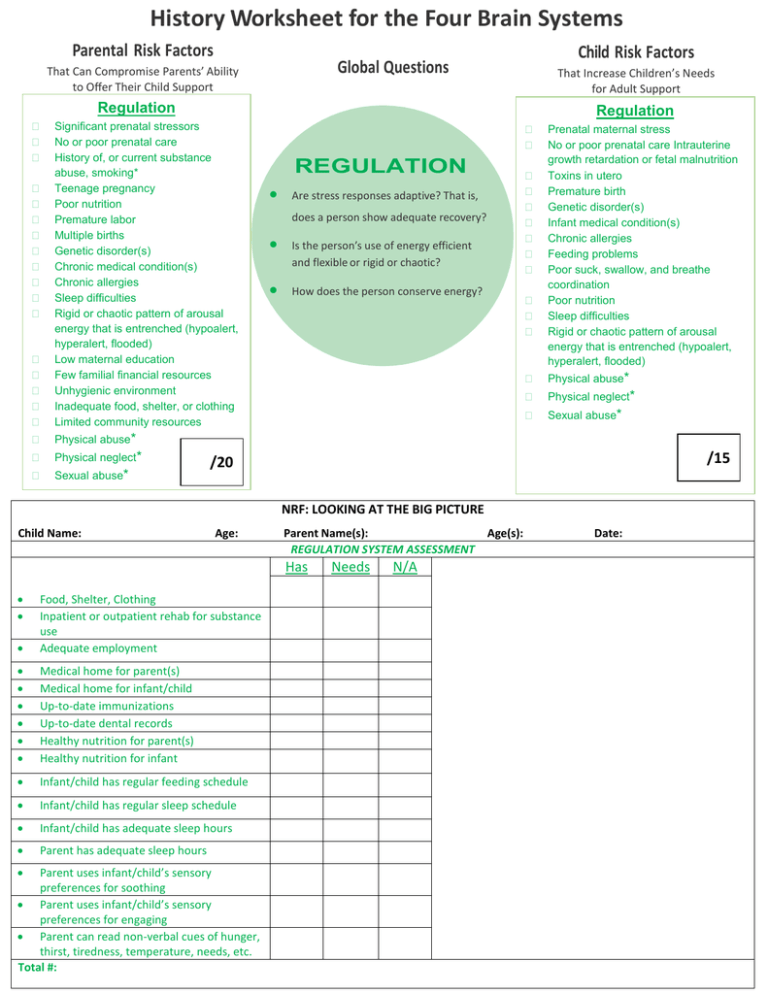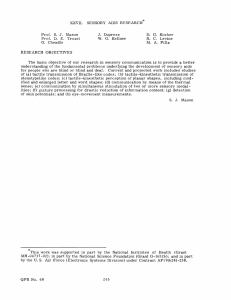History Worksheet for the Four Brain Systems Parental Risk Factors
advertisement

History Worksheet for the Four Brain Systems Parental Risk Factors Child Risk Factors Global Questions That Can Compromise Parents’ Ability to Offer Their Child Support That Increase Children’s Needs for Adult Support Regulation Regulation Significant prenatal stressors No or poor prenatal care History of, or current substance abuse, smoking* Teenage pregnancy Poor nutrition Premature labor Multiple births Genetic disorder(s) Chronic medical condition(s) Chronic allergies Sleep difficulties Rigid or chaotic pattern of arousal energy that is entrenched (hypoalert, hyperalert, flooded) Low maternal education Few familial financial resources Unhygienic environment Inadequate food, shelter, or clothing Limited community resources Physical abuse* Physical neglect* Sexual abuse* REGULATION Are stress responses adaptive? That is, does a person show adequate recovery? Is the person’s use of energy efficient and flexible or rigid or chaotic? How does the person conserve energy? Prenatal maternal stress No or poor prenatal care Intrauterine growth retardation or fetal malnutrition Toxins in utero Premature birth Genetic disorder(s) Infant medical condition(s) Chronic allergies Feeding problems Poor suck, swallow, and breathe coordination Poor nutrition Sleep difficulties Rigid or chaotic pattern of arousal energy that is entrenched (hypoalert, hyperalert, flooded) Physical abuse* Physical neglect* Sexual abuse* /15 /20 NRF: LOOKING AT THE BIG PICTURE Child Name: Age: Parent Name(s): REGULATION SYSTEM ASSESSMENT Has Food, Shelter, Clothing Inpatient or outpatient rehab for substance use Adequate employment Medical home for parent(s) Medical home for infant/child Up-to-date immunizations Up-to-date dental records Healthy nutrition for parent(s) Healthy nutrition for infant Infant/child has regular feeding schedule Infant/child has regular sleep schedule Infant/child has adequate sleep hours Parent has adequate sleep hours Parent uses infant/child’s sensory preferences for soothing Parent uses infant/child’s sensory preferences for engaging Parent can read non-verbal cues of hunger, thirst, tiredness, temperature, needs, etc. Total #: Needs N/A Age(s): Date: REGULATION SYSTEM NOTES Areas of Vulnerability and Need Areas of Strength and Resources Total #: REGULATION SYSTEM RESOURCES Shelters Women’s Crisis Centers Food Banks Housing Agencies Job Placements Rehab for Substance Use HIV/AIDS Crisis Centers Medical Home for Teens/Parents Pediatric Medical Home for Infant/Child Genetic testing center, Geneticist Parental Risk Factors Child Risk Factors That Can Compromise Parents’ Ability to Offer Their Child Support That Increase Children’s Needs for Adult Support Global Questions Sensory Loss of hearing or vision Inaccurate processing of information Slow processing of information Speech abnormality Learning disorder(s) Overreactive to sensory information Underreactive to sensory information Both overreactive and underreactive to sensory information Over or under stimulating living environment Sensory seeker SENSORY How quickly and efficiently does the child/ adult process sensory information? How reactive is the child/adult to sensory information from relationships? Is the child/adult leaning toward types of sensory information that are considered safe as opposed to those that are threatening? Sensory Loss of hearing / vision Inaccurate processing of information Slow processing of information Speech delay Learning disorder(s) Overreactive, to sensory information Underreactive to sensory information Both overreactive and underreactive to sensory information Institutional care or neglect without adequate sensory information Sensory seeker /10 /10 NRF: LOOKING AT THE BIG PICTURE Child Name: Age: Parent Name(s): Age(s): SENSORY SYSTEM ASSESSMENT Has Parent has developmental delays/ disabilities with proper resources Infant/child received newborn hearing screening If premature birth and post Neonatal intensive Care, proper developmental assessments have been done Infant/child received age-appropriate developmental screener (ASQ, PEDS, etc.) Infant/child has had Regional Center assessment Infant/child has appropriate medical care for any disability or delay Infant/child has appropriate child care, pre-school or school setting that matches learning disability needs Parent is learning how to decrease his or her sensory triggers to his or her infant/child Parent is learning how to match his or her infant/child’s sensory preferences Parent is learning how to modulate his or her relational/sensory input Total #: Needs N/A Date: SENSORY SYSTEM NOTES Areas of Vulnerability and Need Areas of Strength and Resources Total #: SENSORY SYSTEM RESOURCES Regional Center(s) Developmental Pediatricians Speech & Language Pathologists Occupational Therapists Physical Therapists Child Risk Factors Parental Risk Factors Global Questions That Can Compromise Parents’ Ability to Offer Their Child Support That Increase Children’s Needs for Adult Support Relevance Relevance A survivor, participant in, or witness to domestic violence* Emotional abuse* Emotional neglect* History of children removed from home; abuse/neglect of other children Multiple children to care for Weak commitment to child Familial history of mental illness* Chronically depressed or anxious Rapid swings into high-intensity emotions; low frustration tolerance Lack of empathy for self and others Difficulty making eye contact and lacking warmth Negative appraisal of child as willfully disobeying or as not loving parent Parent unable to set boundaries and over-accommodates child Discrepancies exist among words, actions, or non-verbal communication Learning disruptions Inability to ask for help when necessary Separation or loss of a parent* /18 Parental criminality* RELEVANCE Is the individual able to express a range of positive and negative emotions flexibly? How do experiences influence memories and appraisals Are emotionally loving, significant, and long-term relationships present? Does the individual tend to attribute positive or negative meanings to experiences? Parent ACE Score /10 Child ACE Score /10 Male preterm infant A survivor, participant in, or witness to domestic violence* Emotional abuse* Emotional neglect* Exposure to domestic violence Traumatic memories Lack of emotional care due to foster care or orphanage placement Chronically depressed or anxious Rapid swings into high-intensity emotions; no frustration tolerance Lack of empathy for self and others Lack of eye contact absence of interest in others and/or lack of social referencing (overly detached) Highly demanding of others Over accommodating to others Lacks one person in the family who is strongly committed to child and who provides loving care Discrepancies exist between words, actions, or non-verbal communication Learning disruptions Separation or loss of a parent* Parental criminality* Inability to ask for help when /19 necessary NRF: LOOKING AT THE BIG PICTURE Child Name: Age: Parent Name(s): Age(s): RELEVANCE SYSTEM ASSESSMENT Has Dyadic socio-emotional milestones have been assessed Parent consistently soothes infant/child Parent consistently engage infant/child with smiles & joy Parent can read emotional non-verbal cues Parent can accurately narrate infant/child’s emotional non-verbal and verbal cues When age appropriate, child has emotional vocabulary for his/her feelings (2 years on up) Parent can recover from stress with self-care strategies Parent has healthy relationships as resources for stress recovery Parent al therapeutic help for past abuse/neglect/trauma Parent-child are receiving dyadic psychotherapy Parental compliance with therapeutic and medical support for personal mood instability Parental compliance with therapeutic treatment for incidents of abuse and neglect Proper child care or educational setting is in place for a child with a trauma history Total #: Needs N/A Date: RELEVANCE SYSTEM NOTES Areas of Vulnerability and Need Areas of Strength and Resources Total #: RELEVANCE SYSTEM RESOURCES Mental Health Centers, Offering Individual Psychotherapy Mental Health Centers, Offering Dyadic Psychotherapy Mental Health Centers Offering Medical, Psychiatric Support Mental Health Offering Psychoeducational/Practical Skills Child Risk Factors Parental Risk Factors That Can Compromise Parents’ Ability to Offer Their Child Support Executive Executive That Increase Children’s Needs for Adult Support Global Questions Motorically clumsy, awkward, or lethargic High distractibility High impulsivity Unable to delay gratification Lacks stable routines Adheres to rigid routines and habits, avoiding novelty Lack of knowledge concerning normative child development Difficulty anticipating the need to sequence and implement agreed-on clinical input Lacks a willingness to incorporate a new way to understand a child’s behavior (e.g., mental rigidity) Is unaware of, or inaccurately judges, own strengths and weaknesses Difficulty using hindsight, insight, and foresight for self-reflection and problem solving Lacks cause–effect reasoning Unable to hold self and others in mind at the same time Unable to consider the part in relation to the whole EXECUTIVE Does child/adult show purposeful movement that is both adaptive and flexible? Can child/adult see the big picture? Can the child/adult stay on track in expressing a thought, emotion, or narrative? Can the child/adult complete tasks in a relatively smooth fashion? /14 Motorically clumsy, awkward, or lethargic Lacks developmentally appropriate use of gestures to communicate needs and wants Lacks developmentally appropriate use of words to problem solve High distractibility High impulsivity Unable to delay gratification Lacks developmentally appropriate abilities to sequence activities of daily living Adheres to rigid routines and habits, avoiding novelty Lacks a willingness to incorporate a new way to understand own or other’s behavior (e.g., mental rigidity) Is unaware of, or inaccurately judges, own strengths and weaknesses Difficulty using hindsight, insight, and foresight for self-reflection and problem solving Lacks cause–effect reasoning Unable to hold self and others in mind at the same time Unable to consider the part /14 in relation to the whole NRF: LOOKING AT THE BIG PICTURE Child Name: Age: Parent Name(s): Age(s): EXECUTIVE SYSTEM ASSESSMENT Has Parent or infant motor delays or disabilities are properly attended to Parental learning challenges have been assessed & treatment plan/team is in place Parental or child assessment for impulsivity and/or inattention has been done, ruling out trauma, learning disabilities, and other clinical issues Parental or child treatment for impulsivity and/or inattention is being attended to Proper child care or educational setting is in place for a child with impulsivity and/or inattention Socio-emotional and child development knowledge is being imparted to parents in the context of his or her individual child Parent is receiving and making use of treatment for developing cause/effect links Parent is receiving and making use of treatment for theory of mind (thinking of others) Child is receiving and making use of treatment for developing cause/effect links (including dyadic work) Child is receiving and making use of treatment for developing theory of mind (including dyadic work) Total #: Needs N/A Date: EXECUTIVE SYSTEM NOTES Areas of Vulnerability and Need Areas of Strength and Resources Total #: EXECUTIVE SYSTEM RESOURCES High-Quality Child Care Centers Early Head Starts Head Starts School Districts




